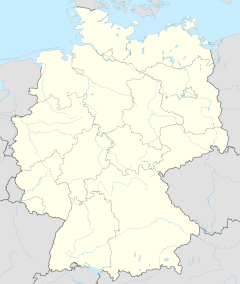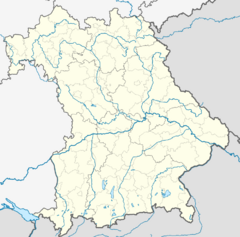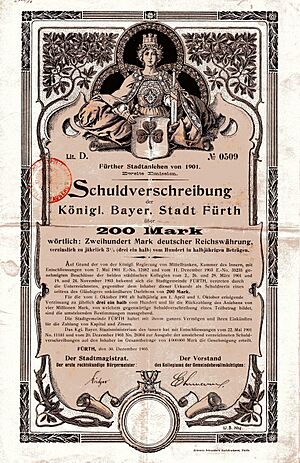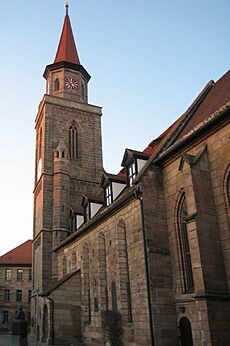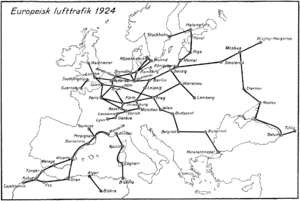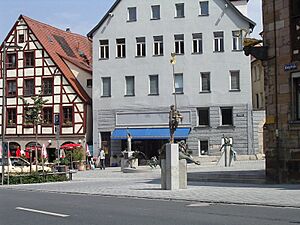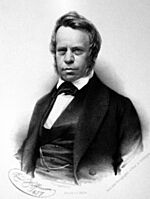Fürth facts for kids
Quick facts for kids
Fürth
Färdd (Mainfränkisch)
|
|||
|---|---|---|---|

View over the city center in direction to Nuremberg
|
|||
|
|||
| Country | Germany | ||
| State | Bavaria | ||
| Admin. region | Middle Franconia | ||
| District | Urban district | ||
| Area | |||
| • Total | 63.35 km2 (24.46 sq mi) | ||
| Elevation | 294 m (965 ft) | ||
| Population
(2022-12-31)
|
|||
| • Total | 131,433 | ||
| • Density | 2,074.71/km2 (5,373.5/sq mi) | ||
| Time zone | UTC+01:00 (CET) | ||
| • Summer (DST) | UTC+02:00 (CEST) | ||
| Postal codes |
90701–90768
|
||
| Dialling codes | 0911 | ||
| Vehicle registration | FÜ | ||
| Website | www.fuerth.de | ||
Fürth (German: [fʏʁt]; East Franconian: Färdd) is a city in northern Bavaria, Germany. It is located in the region of Middle Franconia.
Fürth is the second-largest city in Franconia. It is very close to the bigger city of Nuremberg, with their city centers only about 7 kilometers (4.3 miles) apart.
These two cities, along with Erlangen and Schwabach, form a large urban area. This area is home to about 1.4 million people. The wider Nuremberg Metropolitan Region has around 3.6 million residents.
Fürth celebrated its 1000th birthday in 2007. The city was first mentioned in official records on November 1, 1007.
Contents
Exploring Fürth's Location
The old part of Fürth is east and south of the Rednitz and Pegnitz rivers. These two rivers meet northwest of the Old Town to form the Regnitz river.
West of the city, you'll find the Fürth municipal forest. It is on the other side of the Main-Danube Canal. East of Fürth is Nuremberg. To the north is the Knoblauchsland, a fertile area known for growing vegetables like garlic. Some of this land is actually inside Fürth's city limits.
Towns Near Fürth
Fürth shares its borders with several other towns and municipalities. Here they are, listed clockwise from the north:
These last five are smaller towns within the wider Fürth district.
Different Parts of Town
Beyond the main city area, Fürth includes 20 other smaller localities. These are like neighborhoods or villages that are part of the city.
- Atzenhof
- Bislohe
- Braunsbach
- Burgfarrnbach
- Dambach
- Flexdorf
- Herboldshof
- Kronach
- Mannhof
- Oberfürberg
- Poppenreuth
- Ritzmannshof
- Ronhof
- Sack
- Stadeln
- Steinach
- Unterfarrnbach
- Unterfürberg
- Vach
- Weikershof
A Look at Fürth's Past
Fürth started as a settlement in the mid-700s AD. Its first official mention was on November 1, 1007. This was when Emperor Heinrich II gave his land in Fürth to the new Bishopric of Bamberg.
The name "Fürth" comes from the German word for "ford." This is because the first settlements grew around a place where people could cross a river. Fürth was given the right to hold markets, but it later lost this to Nuremberg. By 1062, Fürth could have markets again, but Nuremberg was already a more important town.
Over the centuries, different groups ruled Fürth. These included the Bishopric of Bamberg, the Principality of Ansbach, and the City of Nuremberg. For a long time, Fürth was mostly a farming community. Around 1600, only about 1,000 to 2,000 people lived there.
During the Thirty Years War, the town was almost completely destroyed by fire. This happened during military actions before the Battle of Fürth in September 1632.
A very important event happened in 1835. The first German railway opened between Nuremberg and Fürth.
During the Cold War, Fürth had many NATO soldiers, especially from the U.S. Army. This was because it was close to the borders of East Germany and Czechoslovakia.
How Fürth Grew Over Time
Over the years, Fürth expanded by adding nearby towns and villages. This helped the city grow bigger. For example, Poppenreuth was added in 1900, and Burgfarrnbach in 1923. Many other areas joined Fürth, especially in 1972.
How Fürth's Population Changed
In the Middle Ages, Fürth's population grew slowly. This was due to wars, diseases, and famines. During the Thirty Years War, the town lost about half its people. In 1634, soldiers set fire to Fürth, and it was almost completely destroyed. After the war, only about 800 people lived there.
In 1685, Huguenots, who were French Protestants, settled in Fürth. By 1700, the town had recovered, and its population grew to about 6,000.
When industrialization began in the 1800s, the population grew quickly. In 1800, Fürth had 12,000 people. By 1895, this number had quadrupled to 47,000. In 1950, Fürth's population went over 100,000, making it a "Großstadt" (large city).
By the end of 2005, Fürth had 113,076 residents, which was a record high. This makes Fürth the second-largest city in Middle Franconia. As of 2015, about 18% of Fürth's residents were from other countries.
Different Religions in Fürth
Christianity in Fürth
Fürth was originally part of the Bishopric of Würzburg. From 1007, it belonged to the Bishopric of Bamberg. In 1524, during the Reformation, Fürth became a Protestant town. It stayed Protestant for many years. However, because of its ties to Bamberg, some Catholics always lived in the town.
After 1792, Protestant churches in Fürth became part of the Bavarian Protestant Church. This church included both Lutheran and Reformed groups.
The number of Catholics grew from the 1700s. In 1829, the first Catholic church since the Reformation was opened. This was the Church of Our Lady. St. Michael was originally a Catholic church. Protestants took it over during the Reformation. In 1961, Fürth became a Catholic Deanery.
In the 1900s, there were usually about twice as many Protestants as Catholics.
Jewish History in Fürth
Fürth was known for its Jewish community. It was even called "Franconian Jerusalem." Jewish residents were living in Fürth as early as 1440. In 1528, the Margrave of Ansbach allowed two Jewish families to settle in Fürth. After this, the number of Jewish residents grew.
By the 1600s, Fürth had a famous Yeshiva (a school for studying Jewish texts). In 1617, a synagogue was built. In 1653, the first Jewish hospital in Germany was built here. It was also Fürth's first hospital.
When Emperor Leopold I sent Jews away from Vienna in 1670, many wealthy Jewish families moved to Fürth. By 1716, about 400 Jewish families lived in the town. In 1807, about 19% of the population was Jewish.
Later, laws in Bavaria placed more limits on Jewish people. For example, a law in 1813 made it harder for Jews to move to Fürth. The Talmudic academy closed in 1824. However, these restrictions were removed by new laws in the mid-1800s. By 1840, Fürth had 2,535 Jews, which was more than half of all Jews in Bavaria.
In 1862, a Jewish primary school opened, followed by a secondary school in 1882. The Jewish population reached its highest number around 1880, with about 3,300 people.
In 1933, there were 1,990 Jews in Fürth. After the Nazis came to power, this number dropped. In November 1938, during the Kristallnacht attacks, the synagogue was destroyed. Many Jews were sent to concentration camps. Most of the Jews who remained in Fürth either fled or were later deported and killed. By 1944, only a few Jews were left. In total, 1,068 Jews from Fürth were murdered during the Holocaust.
After Second World War, a camp for Jewish Holocaust survivors was set up in Fürth. It closed in 1950.
Today, there is a memorial to the Jewish community in Geleitsgasse square. An old Mikvah (ritual bath) was found in a house. This building now holds the Jewish Museum of Franconia, which opened in 1998.
The old Jewish cemetery, started in 1607, is one of the oldest in Germany. It was damaged during the Nazi era but was restored and is now well-preserved. A new Jewish cemetery opened in 1880 and is still in use today.
Nature and Green Spaces
Fürth has a "Nature Trail for Urban Ecology." It was created in 1999 and expanded in 2003. Both routes start at the Stadthalle underground station. Along the trail, you can learn about different natural areas and their importance for plants and animals. This includes places like churchyards and streams. The trail also explains how some areas are protected and discusses environmental issues.
Fürth gets about 1766 hours of sunshine each year.
The Gustav-Adolf natural spring, near the Rednitz River, was restored in 2000. A small building was put over it. Until the 1980s, the spring water, which is 19°C (66°F), was used for a swimming pool.
Fürth's Sister Cities
Fürth is twinned with several cities around the world. This means they have special friendly relationships.
 Limoges, France (since 1992)
Limoges, France (since 1992) Marmaris, Turkey (since 1995)
Marmaris, Turkey (since 1995) Paisley, Scotland, United Kingdom (since 1969)
Paisley, Scotland, United Kingdom (since 1969) Xylokastro, Greece (since 2006)
Xylokastro, Greece (since 2006)
Economy and How Fürth Works
In July 2019, the unemployment rate in Fürth was 2.9 percent.
The toy industry is a big part of Fürth's economy. Many toy-makers, from small craft shops to large factories, are based here.
Brewing beer was once very important in Fürth. Around the early 1900s, Fürth was even more famous for beer than Munich.
Quelle, a huge mail-order company, was based in Fürth. It was once the largest in Europe before it closed in 2009.
Fürth is also a center for solar energy technology. On sunny days, the local energy company, Infra Fürth, feeds about two megawatts of electricity into the power grid using solar panels. A large solar plant on a former landfill in Atzenhof produces 1 megawatt.
Getting Around Fürth
Airports and Air Travel
In 1914, an airfield was built at Atzenhof. After the First World War, it became the "Fürth–Nuremberg" international airport. This airport was important and was the eighth largest in Germany. Later, the aircraft company Junkers moved its repair and assembly lines to Fürth.
Under the Nazis, the airport was used as a flying school. After World War II, the US Army used the site as a barracks until 1993.
Trains and Subway
The first railway line with steam trains in Germany opened between Fürth and Nuremberg on December 7, 1835. The train was called Adler (Eagle).
Fürth's main station is served by many trains, including local S-Bahn lines and longer-distance Intercity and InterCity Express services. There are also several S-Bahn stations throughout the city.
Nuremberg and Fürth are connected by an underground railway (subway). In Fürth, there are currently seven subway stations: Stadtgrenze, Jakobinenstraße, Fürth Hauptbahnhof, Rathaus, Stadthalle, Klinikum, and Hardhöhe.
Waterways
A canal connecting Bamberg and Nuremberg started operating in 1843. There was a port in Poppenreuth. A new canal, the Rhine-Main-Danube Canal, was finished in 1992. This canal created a way for ships to travel from the Rhine River to the Black Sea.
Local Public Transport
Public transport in Fürth is managed by a company called Infra Fürth.
News and Media
The Fürther Nachrichten is a daily newspaper published in Fürth. It started in 1946 as a local section of another newspaper. Today, it is its own newspaper, but it shares much of its content with the Nürnberger Nachrichten. It has special sections just for Fürth.
Major Companies in Fürth
Many well-known companies have their roots or offices in Fürth:
- The mail-order company Quelle was founded here in 1927 by Gustav Schickedanz.
- Grundig, an electronics company, had its main office and factories in Fürth for many years. Its former headquarters is now a technology park called "Uferstadt Fürth." It houses research centers and other businesses.
- Siemens AG, a large global company, has several locations in Fürth.
- Uvex, a company that makes safety products, has its headquarters and a factory in Fürth.
- Toy manufacturers like Simba Dickie Group and Bruder are also based in Fürth.
Schools and Learning
Fürth has 22 elementary schools. There are also three high schools (called gymnasia) where students prepare for university. These are Hardenberg-Gymnasium (founded 1833), Heinrich-Schliemann-Gymnasium (1896), and Helene-Lange-Gymnasium (1907).
There are also two "commercial" schools and several vocational schools for job training.
In 2004, Erlangen-Nuremberg University opened a research center in Fürth. This makes Fürth a university town. Some medical students from Erlangen also get practical training at Fürth's municipal hospital. There is also a private university for health care and welfare.
City Facilities
Fürth has a public swimming complex called Bäderland Fürth. It includes indoor and outdoor pools, a diving pool, and a thermal spa. These facilities were renovated in 2006–2007.
The city also has a municipal library with several branches. You can access its catalog online. There is also a town archive in Burgfarrnbach.
Culture and Things to See
Theatres in Fürth
The municipal theatre (Stadttheater Fürth) is a beautiful building. It was built in the Italian Renaissance and Baroque styles. It looks very similar to a theatre in Ukraine, designed by the same architects.
Another theatre, the Comödie Fürth, is in an Jugendstil building. It often hosts famous German comedy shows.
Places to Eat and Shop
Fürth's main area for eating and drinking is around Gustavstraße. This street is in the Old Town, near the Rathaus. You can find many small pubs, cafés, and restaurants serving traditional Franconian food.
For shopping, Fürth has the Neue Mitte mall and many other shops. There is also an open market. A new mall called Flair is being built and is expected to open in April 2021.
Famous Sights in Fürth
Historic Buildings and Monuments
Fürth was not as damaged during World War II as many other German cities. Because of this, many historic buildings are still standing. Fürth has a lot of historic buildings for its size.
The city center has many streets with well-preserved buildings from the 1800s and early 1900s. In the old town, near St. Michael's Church, you can see buildings from the 1600s and 1700s. The Hornschuch Promenade is famous for its beautiful apartment houses from the Gründerzeit and Jugendstil periods. The southern part of town also has many historic buildings, which were once homes for workers.
The Rathaus (Town Hall) was built between 1840 and 1850. It was designed in the Italian style, similar to the Palazzo Vecchio in Florence. Its 55-meter (180-foot) tower is a main landmark of Fürth.
The historic main train station building was designed in 1863–1864. In front of it is the Centaurenbrunnen fountain, built in 1890. It celebrates the railway and water supply in Fürth.
Schloss Burgfarrnbach (Burgfarrnbach Palace) was built from 1830 to 1834. It is the largest neo-classical palace in South Germany. Today, it is used as a municipal archive and for concerts.
Museums to Visit
- The Jewish Museum in Franconia (Königstraße 89) opened in 1999. It is in a house from the 1600s where Jewish families once lived. You can see old stucco ceilings, a historic Sukkah, and a Mikvah (ritual bath). The museum also has a bookshop and café.
- The Fürth Radio Museum (Kurgartenstraße 37) is dedicated to the history of radio.
- The Stadtmuseum (Municipal/Town Museum) at Ottostr. 2 shows a lot of town history. It has a permanent exhibition and special changing exhibitions.
- The kunst galerie fürth (Königsplatz 1) opened in 2002. It is a place for modern art, with different exhibitions.
Churches to See
The Protestant Church of St. Michael is the oldest building in Fürth. It dates back to around 1100. Its 45-meter (150-foot) tower was added around 1400. Most of the church was built in the 1400s. The inside of the church is mostly Neo-Gothic. The most valuable artwork is a tabernacle on the North wall, created around 1500–1510.
Other churches with Gothic parts from the 1300s to 1500s include St. Johannis in Burgfarrnbach, St. Peter and Paul in Poppenreuth, and St. Matthäus in Vach. St. Peter and Paul might have even older parts, possibly founded around 900–1000.
The Catholic Church of Our Lady (1824–1828) is a Classical style building. The Protestant "Church of the Resurrection" (1825–26) is also Classical. In the Südstadt area, you can find the Neo-Gothic Church of St. Paul and the Neo-Baroque Church of St. Henry and Kunigunde.
Parks and Green Spaces
The Stadtpark (municipal park) is next to the Pegnitz River. It has paths, benches, duck ponds, a playground, a minigolf course, and a rose garden. There's also a special garden for school projects.
The Südstadtpark opened in 2004. It is on the site of a former military barracks.
Fun Events in Fürth
Fürth hosts many regular events throughout the year:
- May: Burgfarrnbach fair (Bürgerfest)
- Spring: International Klezmer Festival (music festival)
- Spring and Autumn: Grafflmarkt flea market
- Summer: Fürth Festival (in the town center)
- Summer: Grüne Nacht (Green Night) - a local Folk & Blues Festival at the "Grüner Markt"
- Summer: New Orleans Festival at "Fürther Freiheit"
- Summer: Hardhöhe festival
- Summer: Saints' day fairs in different locations (celebrating local church consecrations)
- September/October: Michaeliskirchweih fair. This is one of the biggest and most important festivals in Bavaria and Fürth. It has been happening for over 800 years. It usually lasts 12 days.
- December: Christmas market (Weihnachtsmarkt) at Fürther Freiheit
- December: Old Town Christmas (Altstadtweihnacht) at Waagplatz
Awards from Fürth
Since 1996, Fürth has given out the Jakob-Wassermann prize every two years. This is a literature prize named after the famous author Jakob Wassermann, who was from Fürth.
Sports and Fun Activities
Sports in Fürth
Fürth is well-known in the sports world for its football club, SpVgg Fürth. This team won the German football championship three times. After merging with another club, it is now called SpVgg Greuther Fürth. In 2012, the team moved up to the top German football league, the Bundesliga, for the first time. Their stadium is in Ronhof.
The baseball team, Fürth Pirates, was promoted to the top national baseball league in 2002. They became vice-champion in 2004.
Every August, Fürth hosts the annual Paul Hunter Classic. This is a professional and amateur snooker event.
Leisure and Recreation
Fürth has a large public barbecue area near the Rednitz River. It has barbecue facilities and seating, shaded by trees.
You can also find minigolf courses in the Stadtpark, by the Rhine-Main-Danube Canal, near Burgfarrnbach, and by the Pegnitz River.
Famous People from Fürth
Many notable people were born or lived in Fürth:
- Max Bernstein (1854–1925), a lawyer and writer.
- Hans Böckler (1875–1951), a German politician and union leader.
- Ludwig Erhard (1897–1977), a politician who became a German chancellor.
- Roger C. Field (born 1945), an inventor and designer.
- Albert Forster (1902–1952), a German Nazi governor.
- Max Grundig (1908–1989), who founded the electronics company Grundig.
- Jakob Henle (1809–1885), an anatomist and doctor.
- Heinrich Hoffmann (1885–1957), Adolf Hitler's personal photographer.
- Henry Kissinger (1923–2023), who was a United States Secretary of State.
- Wilhelm Löhe (1808–1872), a Lutheran pastor.
- Gustav Schickedanz (1895–1977), a German business owner.
- Alfred Schwarzmann (1912–2000), an Olympic gymnast.
- Leopold Ullstein (1826–1899), an important German publisher.
- Jakob Wassermann (1873–1934), a famous writer and novelist.
- Marco Wittmann (born 1989), a racing driver.
Images for kids
-
Hotel-Pyramide on the east bank of the Rhine–Main–Danube Canal with a glass outside facade
See also
 In Spanish: Fürth para niños
In Spanish: Fürth para niños




